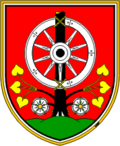Muta (Slovenia)
|
Muta Hohenmauthen |
|||
|
|||
| Basic data | |||
|---|---|---|---|
| Country |
|
||
| Historic region | Lower Styria / Štajerska | ||
| Statistical region | Koroška (Slovenian Carinthia) | ||
| Coordinates | 46 ° 37 ' N , 15 ° 10' E | ||
| height | 366 m. i. J. | ||
| surface | 38.3 km² | ||
| Residents | 3,389 (January 1, 2017) | ||
| Population density | 88 inhabitants per km² | ||
| Telephone code | (+386) 02 | ||
| Post Code | 2366 | ||
| License Plate | SG | ||
| Structure and administration (as of 2017) | |||
| Mayor : | Mirko Vošner | ||
| Mailing address | Glavni trg 17 2366 Muta |
||
| Website | |||
Muta ( German : Hohenmauthen ) is a town and municipality in Slovenia . It is located in the historical Spodnja Štajerska ( Lower Styria ) region, but now belongs to the statistical region of Koroška ( Carinthia ).
geography
location
The southern parts of the municipality of Muta, which include the main town of Muta and the village of Gortina, are located on a wider part of the Drautal , while the northern parts are part of the hilly Kozjak ( Possruck ). The latter are based on the stream Mučka Bistrica ( Feistritz ) coming from Austria , which forms a deep cut into the hill country.
Community structure
The municipality comprises six localities. The German place names in brackets were used by the predominantly German population until the area was ceded to the Kingdom of Serbs, Croats and Slovenes in 1918 and are largely uncommon today. (Population figures as of January 1, 2017):
- Gortina ( Gegenthal ), 616
- Mlake 1 ( Laaken ), 40
- Muta ( Hohenmauthen ), 2.193
- Pernice ( Pernitzen ), 121
- Sveti Jernej nad Muto 1 ( Sankt Barthelmä am Rothwein ), 127
- Sveti Primož nad Muto ( Sankt Primon ob Hohenmauthen ), 292
1 The villages of Mlake and Sveti Jernej nad Muto were divided into two by the Treaty of Saint-Germain on September 10, 1919. The Austrian villages of Laaken and Sankt Barthlmä now belong to the municipality of Eibiswald .
The municipality draws part of its drinking water from the Lorber spring in Austria : this spring is located approx. 400 m beyond the Slovenian-Austrian border in the area of the Staudacher forest estate in Laaken , municipality of Eibiswald , Styria . The aqueduct crosses the state border at the boundary stone Oe / Rs XIV / 234 ⊙ , it is approx. 1200 m long and feeds the water into the pipeline network of the Muta municipality. The opening was on August 17, 2020.
Neighboring communities
| Eibiswald ( A ) | Eibiswald ( A ) | Radlje ob Dravi |
| Dravograd |

|
Radlje ob Dravi |
| Dravograd | Vuzenica | Vuzenica |
history
The place got the name Muta from a toll station between the Duchy of Carinthia and the Mark an der Drau . This toll booth was first mentioned in 1192. The location on the Feistritzbach (Mučka Bistrica) shortly before the confluence with the Drava was ideal for this. In the 15th century, two castles were built from which the traffic could be easily monitored. In the castle Kienhofen a museum is housed.
In 1900 the market town of Hohenmauthen had 1,083 inhabitants, of which 945 were German and 121 were Slovene.
Until 1918, at the end of the First World War , Mahrenberg belonged to the Crown Land of Styria , Cisleithanien , Austria-Hungary .
Web links
- Website of the municipality in Slovenian
- Brief information about Muta in German
- Tourist site in German
- Map of the municipality of Muta
Hohenmauthen around 1877 (recording sheet of the state survey )
Individual evidence
- ↑ Klaus-Jürgen Hermanik: A hidden minority: micro studio on bilingualism in the Styrian region of Soboth . Verlag Publication PNo1, Provincial Library, 2007, ISBN 978-3-85252-817-5 , pp. 222 ff . ( google.at [accessed on March 7, 2019]).
- ↑ Special map of the Austro-Hungarian Monarchy 1: 75,000 - Unterdrauburg 5354. (1914)
- ↑ Population tables of the Statistical Office of the Republic of Slovenia ( Slovene )
- ↑ A border is overcome "fluently" . In: Weststeirische Rundschau , ZDB -ID 2303595-X , Simadruck Aigner u. Weisi, Deutschlandsberg No. 35, August 28, 2020, p. 12.
- ^ KK Central Statistical Commission, Community encyclopedia of the kingdoms and countries represented in the Imperial Council. Edited on the basis of the results of the census of December 31, 1900. Volume IV Styria (Vienna 1904) p. 288.





